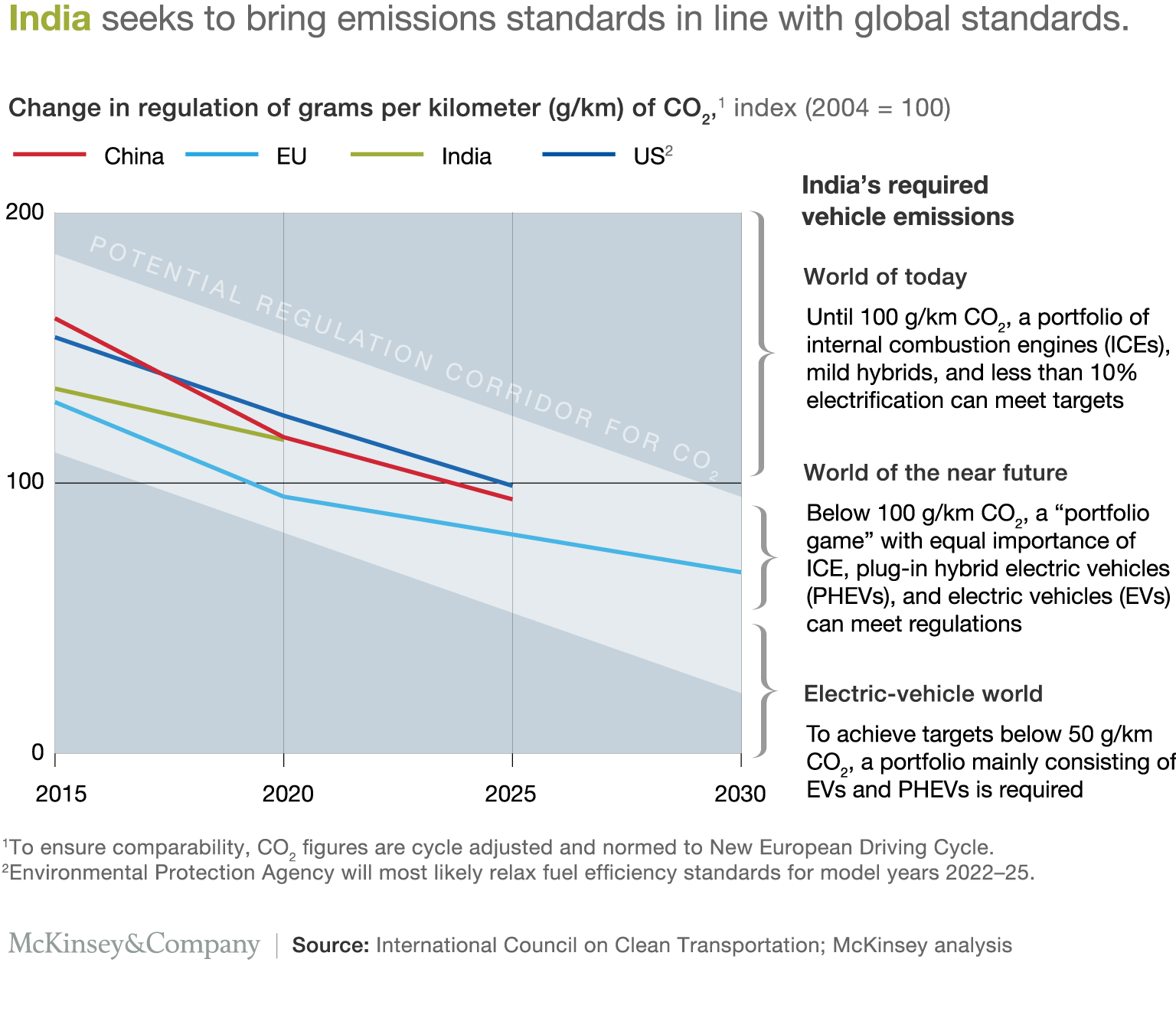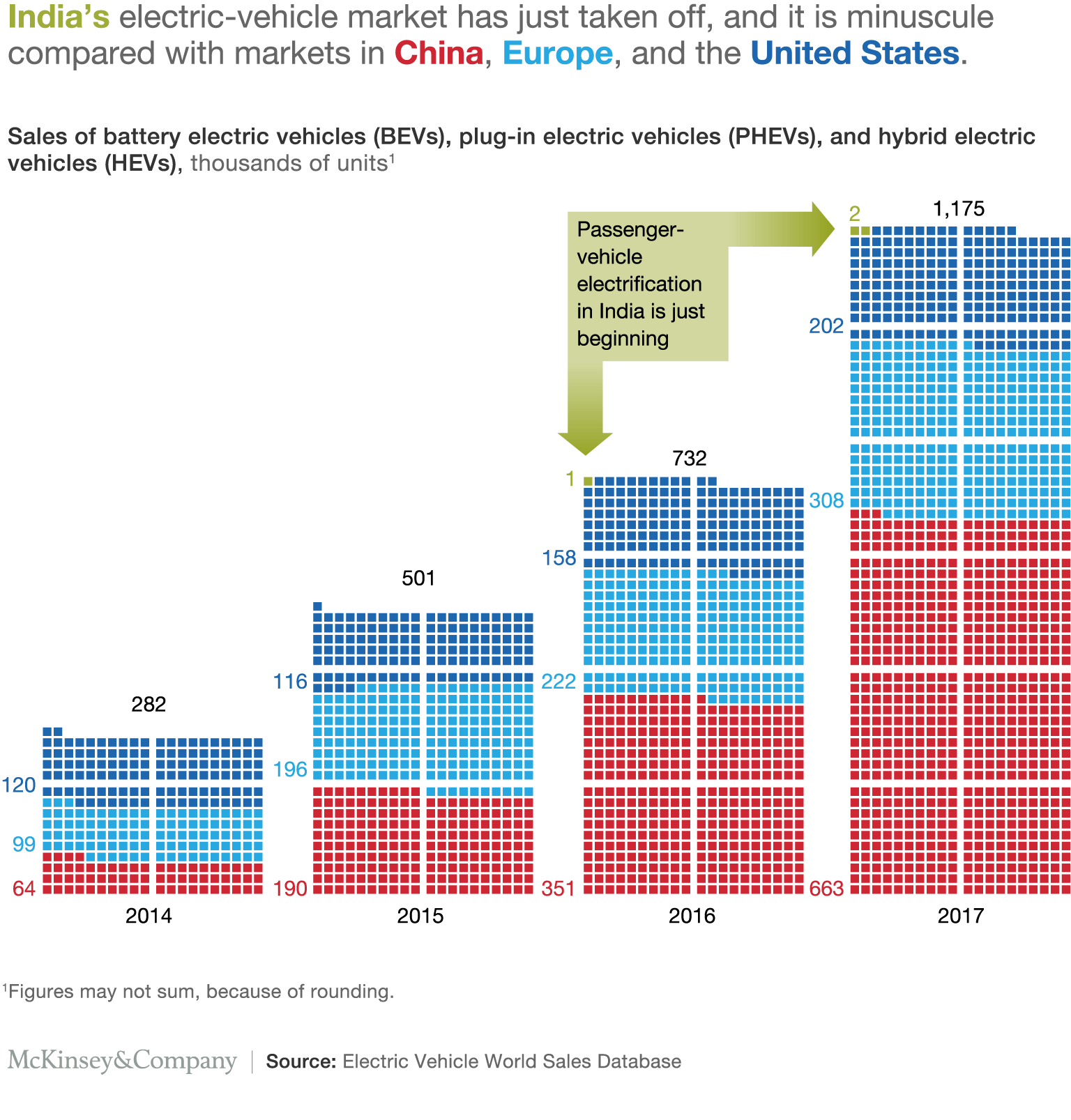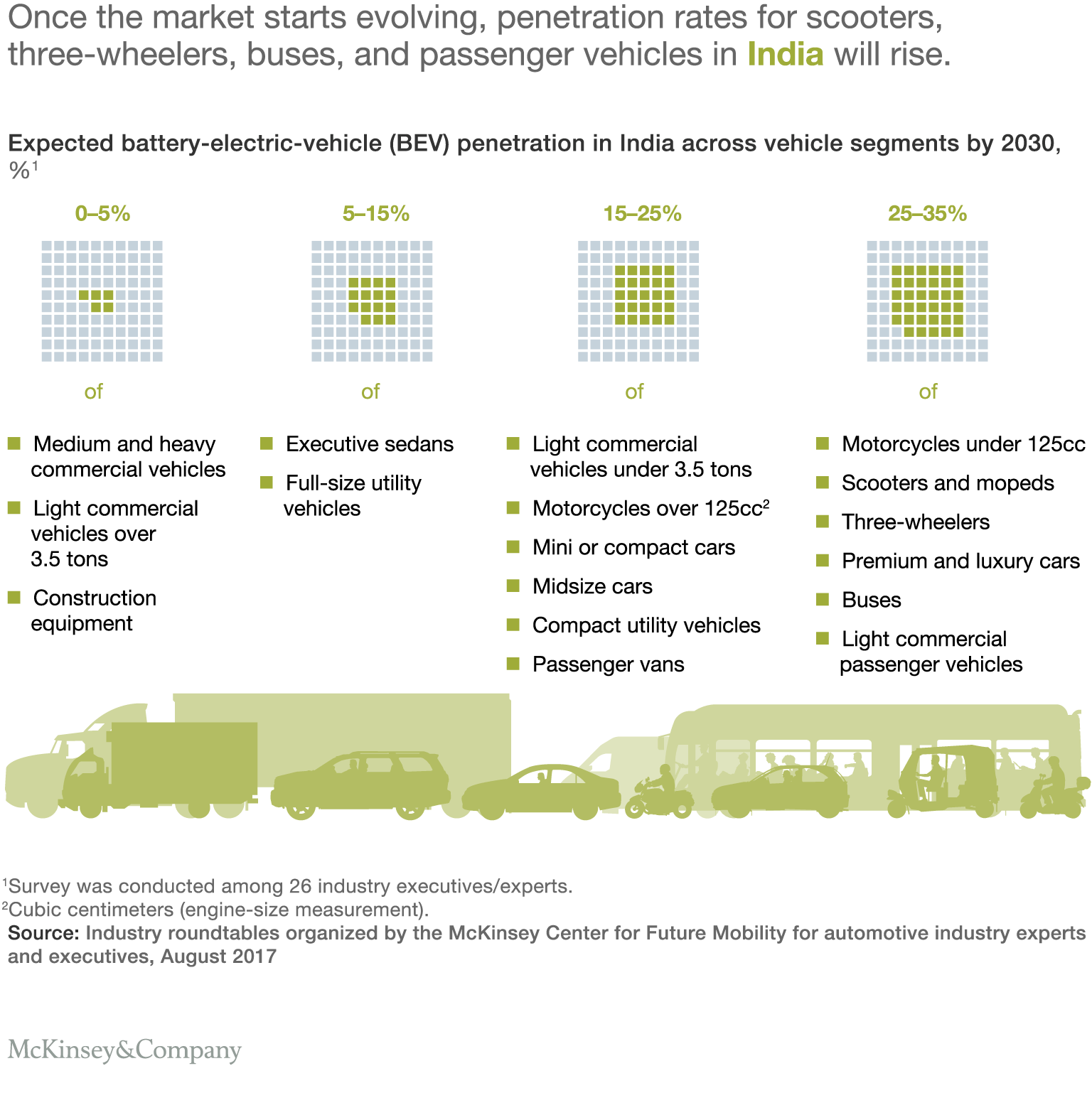With this growth in mind, we set out to build a perspective on the trends shaping the Indian market, the value proposition for the automobile industry in India, and imperatives for winning in the market. This article explores all three.
Key trends shaping the Indian passenger-vehicle market
The market for passenger vehicles in the country will evolve in the context of several larger trends, some specific to India, and some relevant globally.
Favorable macroeconomic and demographic trends
Currently, the automotive sector contributes more than 7 percent to India’s GDP.4 The Automotive Mission Plan 2016–26 sets an aspiration to increase the contribution to 12 percent.5
A number of economic trends could help in meeting this target. Rapid urbanization means the country will have over 500 million people living in cities by 2030—1.5 times the current US population. Rising incomes will also play a role, as roughly 60 million households could enter the consuming class (defined as households with incomes greater than $8,000 per annum) by 2025. At the same time, more people will join the workforce. Participation could reach 67 percent in 2020, as more women and youth enter the job market, raising the demand for mobility.
Some of them would leap straight into four-wheeler segment, and others will graduate from two- to four-wheelers. Over 44 percent of the consuming-class households will be in 49 growth clusters—for example, Delhi is expected to have the same GDP per capita at purchasing power parity as the entire country of Russia in 2025.6 Cities like Delhi are a sweet spot for car manufacturers to target.
In the future, these macroeconomic and demographic trends could shift pockets of growth in passenger-vehicle market. Mini cars and hatchback cars have been the mainstay for the automobile industry in India, with share around 50 percent and growth of 6 to 7 percent between financial year 2014 and 2017. These segments will continue to maintain a dominant position, but the majority of growth is expected to come from new segments such as compact SUVs, sedans, and luxury vehicles.
Continued government focus on supporting the industry
Through the Automotive Mission Plan, the National Electric Mobility Mission Plan (NEMMP), and other initiatives, the government seeks to achieve two objectives—facilitate long-term growth in the industry and reduce emissions and oil dependence.
In the Automotive Mission Plan 2026, the government and industry set a target to triple industry revenues, to $300 billion, and expand exports sevenfold, to $80 billion. To meet these aims, it is estimated that the sector could contribute more than 60 million additional direct and indirect jobs, and the result could be improved manufacturing competitiveness and reduced emissions.
To tackle emissions, the government seeks to bring local standards up to par with global standards, enabling India to leapfrog from BS-4 to BS-6 emissions (the Euro 6 equivalent) by 2020 (Exhibit 1). Additionally, India has implemented Corporate Average Fuel Efficiency norms in which the manufacturers have to improve their fuel efficiency by 10 percent between 2017 and 2021 and by 30 percent or more from 2022.

Additionally, to address pollution from old vehicles, the government is working on an initiative that focuses on formulation of end-of-life or scrappage policies. It plans to give incentive for the adoption of these policies with the help of lower taxes, discounts on purchase prices, and simple compliance processes.
To reduce dependency on oil imports, the government is promoting adoption of alternative fuels through FAME2, which is an extension of the original FAME (Faster Adoption and Manufacturing of Hybrid and Electric Vehicles) initiative. Where “FAME1” offered incentives to electric vehicles (EV) and hybrid EV buyers, FAME2 is expected to incentivize electrification of the public-transport fleet of buses and taxis, as well as facilitate demand for all types of alternative fuel. Furthermore, to enable immediate adoption, a lower goods and services tax of 12 percent is applied to battery electric vehicles, compared with 31 to 48 percent for other vehicles.
The development of India as a manufacturing hub
The World Economic Forum ranks India 30th on the global manufacturing index, which assesses the manufacturing capabilities of more than 100 countries. The government’s “Make in India” initiative has played an important role in elevating country’s position. In the past three to four years, India improved on nine out of ten parameters for ease of doing business.
Although there is still a long way to go before India becomes a leader in the manufacturing arena, companies in the automotive sector are embracing this opportunity to leverage India as a hub for low-cost, high-quality products. After creating a strong value proposition in mini cars, India is gaining global recognition in the compact sedan and SUV category.
The potential for global disruptions
The global automotive industry is undergoing a cascade of disruptions that will reshape it in unexpected ways, and India will be no exception to this. Four key trends will shift markets and revenue pools, change mobility behavior, and build new avenues for competition and cooperation.
Electrification. Electrification has just started to take off in India (Exhibit 2). Factors such as declining prices of batteries and supportive policies from the government are stimulating the segment’s growth. In 2017, only 2,352 units of electric vehicles were sold.7 However, early signs of growth are visible through an order for 10,000 electric vehicles by the government’s energy-service company known as Energy Efficiency Services Limited. Likewise, local governments in ten cities, with populations of one million or more people, have placed orders for 390 electric buses during phase one. In the next phase, the order book is expected to be in the range of 1,000 e-buses.8

The pros and cons of electrification continue to evolve. Reduction in emissions and less dependency on oil imports are clear advantages of electrification. The level of adoption of electric vehicles will determine its impact on the automobile industry. According to industry experts, people carriers like buses, two- and three-wheelers, luxury passenger vehicles, and light commercial vehicles could see maximum penetration by 2030. This will be followed by other passenger vehicles, medium- and heavy-commercial vehicles, and construction equipment, which will take longer for EVs to penetrate (Exhibit 3).

From a customer point of view, the value proposition of electric vehicles will be reduced total cost of ownership, particularly in applications where asset utilization can be high. India is yet to see mass-market EV platforms, but both incumbents and new entrants are making efforts and the inflection point of volume growth may not be too far out.
However, this trend requires careful planning and execution, as there are certain risks associated with it. These include dependence on China for raw material, competitive disadvantage in power electronics and battery manufacturing, and lack of infrastructure—for example, there are fewer than 1,000 charging stations in India. Moreover, many consumers remain wary of electric vehicles because of the cost, range anxiety, and lack of options.
Shared mobility. Penetration of shared mobility in India remains low compared with China and the United States, but a major shift is under way in densely populated cities where the use of e-hailing cabs costs less, comparatively, than driving a personal car. Major stakeholders from the government to automakers to venture-capital funds and cab aggregators agree that the industry will continue to grow, becoming a significant alternative to commuting in growing urban areas. For example, two of the major cab aggregators covered 500 million trips together in 2016; that number is expected to rise with innovative models like cab-pooling and pay-later options.
The pace of this change likely depends on three main triggers: first is asset utilization, where cab aggregators’ ability to sweat their assets will determine their ability to expand and offer more competitive rates to customers while letting drivers earn. Second, clarity in regulations will simplify compliance and encourage more people to join the movement. Third, several cities in India are investing heavily to upgrade their transport infrastructure. This is not just limited to building metros in big cities. The role of shared-mobility players will evolve as transport infrastructure becomes mature. At the moment, rides and driver incentives are funded by private capital, which makes the model economically viable. It will be important to see how the industry fares once private capital dissipates.
Connected vehicles. Connectivity is still in the early stages of adoption in India. A minuscule share of vehicles sold in India come with factory-fitted connectivity features, but the mass adoption of smartphones, coupled with low data costs, could enable connectivity features to proliferate.
There are several connectivity-linked applications that are picking up in India. Basic in-car entertainment, navigation, and in-car connectivity (for example, through Bluetooth) have evolved rapidly over the last decade. More advanced telematics features that utilize car sensor data, driving behavior, and vehicle-health parameters are also evolving, particularly with aftermarket solutions. Several start-ups are leveraging this data coupled with proprietary hardware and algorithms to build solutions centered on improving safety and security, tracking vehicle activity or theft, monitoring and influencing driver behavior, and enabling timely repairs and maintenance.
Car connectivity also leads to several risks around which protocols and guidelines are at very early stages, not just in India but also globally. Data security, privacy concerns, cyberthreats are new challenges that vehicle connectivity creates. Moreover, car connectivity affects not just OEMs but also several ecosystem players, including insurance companies, telecom operators, and technology companies.
We see some early signs of adoption visible in the ecosystem. For example, one major vehicle-insurance player in India offers discounts on premiums if the vehicle has an antitheft device. Several automakers have recently introduced connectivity features, including infotainment, navigation, and communication interfaces. IRDA, the insurance regulatory body, has also invited views on pay-as-you-drive insurance products that use telematics to affect premium prices.
Autonomous vehicles. Autonomous vehicles (AVs) offer promise to resolve some of India’s road-safety challenges. Drivers and passengers in India see about 12 percent of global road fatalities, and more than 80 percent of road accidents involve some aspect of driver error.9 AVs have the potential to reduce traffic congestion and improve safety and fuel efficiency.
However, neither industry nor regulatory players are confident of rapid AV sales uptake due to fear of job loss, weak infrastructure (for instance, traffic), lack of technological readiness, and lack of self-discipline in the driving culture. That said, certain advanced driver-assistance systems features such as park assist, navigation service, anti-lock brake assistance, electronic stability program, and others have started to make their way into vehicles in India. And once the Bharat New Vehicle Safety Assessment Program10 comes into full force these features will see significant uptake.
Value proposition of India
Given these trends, what role might India play in the automobile industry of the future? A few themes could emerge.
Win here, win all
In many ways India is an archetype for emerging markets in regions such as Latin America, Southeast Asia, and Africa. The scale might be different, but these markets experience similar opportunities and challenges—a burgeoning consuming class, value-focused tastes and preferences, and an evolving manufacturing ecosystem, among other attributes.
Companies that have developed products in India and for India have been able to find markets in other continents as well. For instance, Ford India Private Limited is exporting over 90,000 EcoSport cars per year, almost twice the amount of domestic sales. Similarly, Hyundai and Volkswagen are using their factories in India as a global hub for compact hatch and sedans.
Center for frugal engineering
For a long time, India has been known as a hub for frugal engineering. Many global companies have used jugaad (roughly translated, frugal engineering) to develop products that cost a fraction but offer enough value to attract demand. For example, a leading global automobile company selected a team of engineers in India to build a car for emerging markets. The team was asked to focus on ground-up innovation, heavy local sourcing, and local tastes and preferences. The result of this effort was a mini car sold for around $5,000 that offered all the latest features, technology comparable to industry leaders, and localization levels of 98 percent. The company has been selling more than 8,000 vehicles every month and has become an attacker for incumbents in the small-car segment.
Embedded software
In the near future, most automobile manufacturers will have to embed software in their vehicles to manage the complex system of hardware such as sensors, processors, and storage devices. This is a great opportunity for Indian IT and auto-component players, many of whom have started developing a global play to gain the first-mover advantage. For example, Sasken Technologies is working with more than 100 Fortune 500 companies to apply embedded software in their products. In one such case, the company collaborated with a North American Tier 1 supplier to develop a testing framework for telematics in a vehicle. Similarly, AllGo Embedded Systems, which was acquired by Visteon Corporation in 2016, was one of the first movers in the embedded multimedia and connectivity solutions space and became an important supplier to global automobile manufacturers and tier-one suppliers. Its patented technology gave Visteon Corporation a strong play in Linux and Android-based solutions.
Hub for low-cost, high-quality managerial talent
For a number of years, multinationals have been using India as a hub for low-cost talent. However, in the past few years, India has also been recognized for high-quality managerial talent. Indians are starting to occupy major positions across industries such as consumer goods, automotive, pharmaceutical and banking, among others. Moreover, many such companies are also leveraging local talent for driving innovation through R&D centers. In the case of a leading global conglomerate, more than a quarter of their innovations are done by the team in India. Likewise, in the case of an automotive manufacturer, the local team of managers and engineers are working on products that will drive growth in the medium to long run.
Imperatives for winning in India
As various local and global players expand their positions in India, companies need to design winning strategies for the market. The following suggestions can improve the chances of winning.
Reimagine and move fast. Reinvent the business because disruptions are either on the way or already here. It makes sense to adopt lean operations, bundle new products with solutions and services, and explore additional value-chain opportunities.
Make in India for India. As Indian consumers move up the income ladder, their definition of value will evolve. It will lie in higher quality and features but lower prices when compared with global markets.
Go granular. As pointed out earlier, a large share of demand in India will come from 49 clusters and rural pockets. It is important for companies to outline their addressable clusters up front and invest in appropriate products.
Partner to build relevant assets. Prepare the organization to embrace an operating model that involves nontraditional partners as high-tech and automotive worlds merge. The sheer size of the opportunity in the industry has attracted many large tech companies and start-ups. As a result, incumbents will have to adjust their operating model and prepare to work closely with nontraditional companies in the value chain.
Empower the organization in India and invest in talent. Prepare a top team of 10 to 15 leaders and give them the autonomy to drive change. Invest in talent to avoid a skills war in the future.
Embrace technology. Develop a clear and time-driven strategy for embracing digitization, big data analytics, and connectivity. Appoint a chief technology officer to build and manage the integration of new technologies.
India’s automotive industry and market are on the cusp of major change. The opportunities generated by the disruptions ahead can change the competitive game for players willing to step beyond their traditional roles and engage with customers in this new, digital environment.















